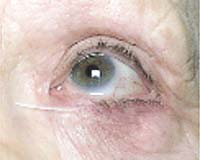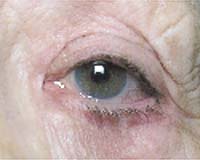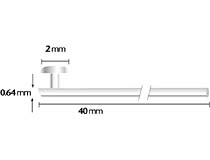Monocanalicular stent used to dilate stenotic punctum
Mini-Monoka tube often reduced in length to prevent lacrimal sac contact.
TAMPA, Fla. - The mini-Monoka (FCI Ophthalmics; Marshfield Hills, Mass.) is a silicone monocanalicular stent designed to repair canalicular lacerations. J. Justin Older, MD, an oculoplastic specialist here, instead uses the device to dilate the stenotic punctum and canaliculus.
Dr. Older has used the mini-Monoka for the past 2 years. “I specifically purchased the device for this alternative use. I don’t perform any canalicular laceration repairs, he said. To date, Dr. Older has treated about 20 patients.
“All but one patient has had their punctum remain open,” Dr. Older said. “In one case, though, the tube came out.”
Dr. Older has also used the mini-Monoka to dilate the canaliculus in some patients without lacerations. But results have been mixed for this condition. “Some worked, some didn’t,” Dr. Older said.
Tube cut
 ---Mini-Monoka
tube lying on lower lid in proper orientation to
canaliculus.
---Mini-Monoka
tube lying on lower lid in proper orientation to
canaliculus.
For treating punctal stenosis, Dr. Older first
dilates the punctum with punctal dilators, then inserts the mini-Monoka into
the canal. “I often cut the tube, which is approximately 3 cm long, to a
length of 1 cm or 15 mm,” he said. “The tube doesn’t need to
reach all the way into the lacrimal sac. Sometimes the tube won’t turn the
corner, so I can’t push it in. I advance the tube into the canaliculus.
The mini-Monoka has a small area that looks like a heel. This fits into the
perpendicular first 2 mm of the canaliculus,” Dr. Older said. The
“heel” wedges into the ampula, which is the area where the
canaliculus makes a right angle toward the nose.
The mini-Monoka is designed to fit snugly into the punctum and ampula without any suturing. A flat plate at the end of the tube sits over the punctum. “This plate is about the width of the lid margin,” Dr. Older said. “Unless the lid margin turns in, the plate should not rub on the cornea. The plate keeps the tube from migrating into the canaliculus.”
Dr. Older leaves the tube in while the punctum dilates, sometimes for a month or two to stretch the punctum. “Then I pull out the tube and the punctum stays open,” said Dr. Older, a clinical professor of ophthalmology at the University of South Florida here.
No stitching required
 ---Everted lower lid
to show plate of tube over punctum.
---Everted lower lid
to show plate of tube over punctum.
Dr. Older knows of
no other practitioner who uses the mini-Monoka for this application, but he
encourages his colleagues to try it. “It is easy and it is quick,” he
said. “You don’t need to suture the tube to the lid.” This is in
contrast to the past when “we inserted a silicone tube, then stitched it
to the eyelid to keep the punctum open. We’d stitch it to the outside of
the lid so it would not rub on the cornea.” Nonetheless, in certain cases
such as ectropion, “by stitching the tube to the outside of the lid, the
lid would tend to be pulled out,” Dr. Older said.
In the past, Dr. Older treated patients with both ectropion and punctal stenosis first by performing an operation that would turn the lid in, then inserting a silicone tube to keep the punctum open. “I’d stitch the tube to the skin on the outside of the lid. This would tend to pull the lid back out again, so the force of the tube being stitched to the skin was counterproductive to what I was trying to accomplish,” he said. With this technique, “stitches would become loose and then you’d have to change the stitches every 2 weeks.”
In contrast, the mini-Monoka allows a surgeon the flexibility of no longer having to stitch the tube to the skin. “The lid can simply be placed in its normal position,” Dr. Older said. Therefore, “the technique has the advantage of not counteracting the surgical procedure for ectropion.” Having the tube remain for up to 2 months, “is much better for the patient,” he said.
Dr. Older also uses the mini-Monoka tube when he treats canaliculitis. His technique is to create a skin incision with the Ellman (Hewlett, N.Y.) Dual Frequency Surgitron using a thin needle, A-8 or A-10, on a cut setting. A probe is then passed into the canaliculus and scissors are used to cut down on the probe to open the canaliculus. Stones are usually found and removed with a curette or by “milking” the stones out of the canaliculus.
“Once the stones are removed and the area is irrigated with antibiotic, the mini-Monoka stent is passed into the canaliculus,” Dr. Older said. “The canaliculus is repaired with 5-0 chromic suture over the stent and the skin is closed with 6-0 fast absorbing plain gut.”
Dr. Older said he has found this to be much easier for the patient than a silicone tube tied to the skin of the lower lid.
 |  |
| Same patient as figure 2. Plate does not show when lid is in normal position. | FCI Mini
Monoka. |
For Your Information:
- J. Justin Older, MD can be reached at 4444 E. Fletcher Ave., Ste. D, Tampa, FL 33613; (813) 971-3846; fax: (813) 977-2611; e-mail: eyelids@mindspring.com. Dr. Older has a direct financial interest in the products mentioned in this article. He is a paid consultant for Ellman International.
